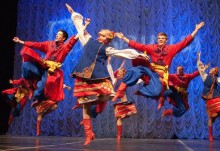Professor Alkis Raftis, President of International Dance Council (CID) at UNESCO first came to Ukraine on an unofficial visit to meet with members of the CID and understand the situation with dancing in Ukraine. International Dance Council is the highest official organization that brings together people and organizations connected with dancing all over the world. It was established in 1973 at the UNESCO headquarters in Paris.
Alkis Raftis is the author of about 30 books on the history of dance, culture, and management. He was born in 1942 in Athens. Before he finally decided to focus on dance, he served as deputy chairman of the National Bank. Raftis is researching the history of plastic art in Greece, defining the place of dance in literature and art. Among the topics that interest Mr. Raftis there are many original ones. In particular, he is interested in the relation between city and a man on the level of rhythm, music, and plastics.
In his interview to The Day Raftis spoke about why the government must quickly outline public policy on dancing and what a true folk dance is.
GOVERNMENT MAY NOT PROVIDE FUNDING BUT IT SHOULD HELP IN OTHER WAYS THEN
“Ukraine is very rich in dances: there are more than 2,000 dance schools in the country. Dancers are very mobile – they easily go abroad to learn new dance techniques or look for a job. They are very open to the world.
“However, you do not only lack government financial support, there is even no defined policy regarding dancing in your country. And it is extremely important to have such policy. We can help Ukrainian government to outline it. Do you want to develop dancing culture or festivals? Do you want to have dance classes in the smallest villages or in all schools (UNESCO suggests that there should be an hour of dancing per week in every school – this proposal was implemented in some countries and Ukraine can become one of them)? Do you want to export Ukrainian dance abroad? Anything can become a part of state policy but it must be determined because you can’t achieve any goals without it. The government may not provide funding but it should help in other ways then.”
YOUNG PEOPLE WHO DANCE WILL NOT USE DRUGS AND WILL NOT BECOME HOOLIGANS
“April 29 is the International Dance Day. If a city decides to celebrate, it will not cost the city anything. All you need to do is to spread the information to all the organizations involved in dancing, asking them to do something that day. For example, all the dancers gather in a square and dance together. Make an announcement about it and people will come to watch.
“Canada, for example, invests a lot of money in dancing. They understand that young people who dance will not use drugs and will not become hooligans. Giving 1,000 dollars for dancing today they will save 10,000 on crime tomorrow.”
I DO NOT SEE FOLK DANCE ANYMORE
“Let’s imagine a Ukrainian village 50 years ago. People then had little contact with the rest of the world. There was a very slow pace of life. And now let’s take a modern city, for instance, Kyiv: the pace of life is very busy. Huge flow of information, newspapers, television, telephones, the Internet – it all is changing us. These changes are reflected in dancing. Urban dances are fast. And folk dances have always been slow. Those folk dances that you see today are not real, they are fake. Choreographers make them very fast, because they are the people of the city and they want to satisfy their audience. I do not see real folk dances anymore. Choreographers do not try to show dances in their historical context, the way they looked before. By modernizing a dance you make it ridiculous.”
HOW TO PRESERVE DANCES
“There is no such thing that one form of dance is good and the other is not. People think that there are high-level dances like ballet, and low-level dances like folk or erotic dances, but it is not true. You can find high quality in every dance if you know what to look for. It is impossible to explain this quality – it can be spiritual filling, glory. Often dancers have good technique of performing and do fantastic things, but somehow do not have this glory.
“There are many dances that are on the verge of extinction. It is important to make video recordings of these dances for future generations, gather them in one library, and wait until people get interested in them. If you lose them, you will no longer be able to revive them. Dance is a form of national memory.”
ABOUT THE INTERNATIONAL DANCE COUNCIL AT UNESCO
“The total number of CID members worldwide is 6,000, including nearly 30 in Ukraine. Most of our members are professionals, of course. But we are open to all. All dance organizations are free to leave us their contact information to be on the list of all the dancers in the world. All they need to do is to fill in a form on our website www.cid-portal.org.”








